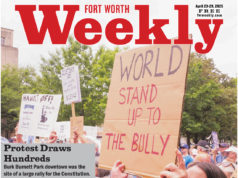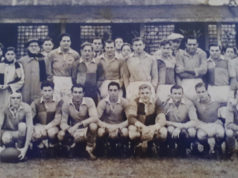At sunset on a cloudy day, he walked down a dirt road on the property, passing the stands of buffalo grass, big and little bluestems, and wildflower meadows with winecups, Indian blankets, and Queen Ann’s lace. As he explained his coalition’s campaign to preserve the prairie, the sounds and sights of the city were far away. Chirping birds drowned out the distant sound of cars on Old Granbury Road. The prairie seemed to lie parallel to the plane of the sky, stretching for an unknown number of miles, only a couple of water towers and a billboard hinting at its limits.
Manos, executive director of the Great Plains Restoration Council, wants to preserve the land permanently. Joining him in the effort are such diverse groups as the American Indian Chamber of Commerce, Spiral Diner, the National Audubon Society, Native Prairie Association, and Black Vegetarians. The Crowley land could become a gateway to what Manos calls the Buffalo Commons. It’s the mission of the Great Plains Restoration Council: putting together a million acres of continuous prairie where buffalo and other wildlife have space to roam freely.
For Manos, preserving the 2000-acre tract doesn’t seem like a distant dream, because the state’s General Land Office already owns the land; therefore, he thinks it should be possible for the state to simply turn it into an “urban wilderness park.” It would be a place where schoolchildren learn about nature and history. In a predictable clash of green versus green, Manos wants to save the land from development, and the state wants to profit from its investment.
“We can’t let the state sell without public pressure,” Manos told his supporters. “The State of Texas is gonna fight this, because they just want to make a buck.”
But the fight isn’t that simple. Last November, the General Land Office bought the tract as an investment for the Permanent School Fund. With real estate investments and other forms of revenue, mostly oil and gas, the Permanent School Fund helps offset local property taxes and annually contributes $800 million toward public K-12 education. Giving up a profit from the investment would take away money that would otherwise support the state’s grossly under-funded public education system.
Jim Suydam, press officer for the General Land Office, explained that to merely preserve the public land would violate the Public School Fund’s constitutional duty of making a return on an investment.
“The main role of the school fund is as a fiduciary. If there are side benefits, like conservation and ecological development, those are auxiliary benefits,” Suydam said. “They don’t drive the decisions.”
It’s standard practice, though, for the General Land Office to do an archaeological assessment of land purchases and to develop recommendations on what needs to be preserved. The agency is working on protecting some of the historical structures on the land.
If the plow doesn’t meet the prairie now, it will later. Unless plans change, the Southwest Tollway will slice through the site. The state was banking on the proximity to the tollway when it bought the tract from rancher Alan Meeker for $21 million. Meeker retained the mineral rights on the land, which sits over the gas-rich Barnett Shale, and will likely make millions in royalty profits. Already scattered on the land are 12 wellheads, and any developer would have to keep residences 300 feet away from the wells, according to city ordinance. For each completed well, several acres will become scorched earth, with not a bluestem in sight.
When State Rep. Anna Mowery of Fort Worth first learned about the tract in her district, she wanted to preserve it. Then she met with State Land Commissioner Jerry Patterson and found out that she was running up against the state constitution.
“I’m not trying to give up, but it’s got problems,” Mowery said. “You can’t get what you want, you get what you can.”
She now hopes the development that does occur won’t overburden the Crowley school district by creating too many homes and not enough taxable businesses on the property.
No deal has been made, but the General Land Office is talking to buyers who could turn the prairie into a mixed-use community. For Manos, anything that develops the majority of the land or fragments the tract is unacceptable.
Of the original 1.3 million acres of Fort Worth Prairie ecosystem, which once ran from the Brazos north to the Red River, only 60,000 acres still remain intact, and half of that is slated for development. Manos is urging others— “people of all colors, cultures, communities” — to get involved in preserving the prairie.
“What people don’t realize is this is what Fort Worth originally looked like,” Manos said. “Once you bulldoze, you go to another ecosystem.”
For former environmental consultant Brian Rowe, who has driven around North Texas looking for prairie, the land near Benbrook Lake is unique. He said the grouping of little bluestem, yellow Indian grass, and big bluestem prairie, which sprouts all over the tract, is very rare, with only 20 known occurrences in the world.
It’s not only plant life that is unique here; remnants endure of a homestead built by a German family in the 1850s. Native American artifacts are strewn across the land, too, part of the reason the American Indian Chamber of Commerce joined Manos’ coalition. Diana Woodward, the chamber’s executive director, knows that the site is important to Fort Worth history.
“Sometimes I feel like Fort Worth is trying to catch up with Dallas [in the way] that we are losing what is unique,” Woodward said.
Bob Skiles, an archaeologist for the land office, spent a day at the prairie looking at the structures that still remain: a house, a gravesite, a stone wall built to control floods.
“It’s in a remarkable state of preservation,” Skiles said of the house. “It’s pretty much stayed the same, except for the natural erosion.”
If the site is sold to a developer, the state probably will retain an historical easement for the 3.5 acres enclosing the barn and house. Sixteen acres in a floodplain, surrounded by a three-mile wall, would also be protected. That’s not enough to meet the Great Plains Restoration Council’s dream of an urban wilderness, however.
The Nature Conservancy’s Jim Eidson said that his organization is always looking for partnerships in conserving land, but it’s unlikely that the group will help buy the Old Granbury Road property. They are working on creating conservation easements totaling 3,000 acres on three ranches in the Fort Worth Prairie area. Very little Fort Worth Prairie enjoys such protection now: The Fort Worth Nature Center includes 600 acres of the ecosystem, and the LBJ National Grasslands north of Decatur has former cropland that is returning to its native prairie state.
Eidson doesn’t see land acquisition as the main strategy for preserving Fort Worth Prairie, especially since prices for land west of Fort Worth continue to rise. Conservation development, where homes are built in one corner of a land and an adjacent natural commons is preserved, is another strategy.
Many people move to the country to be closer to nature, he said, but development usually follows, blocking the sight of the sun setting in an open sky. “The country falls prey to its own allure,” Eidson said. “The views are going to be gone.”











